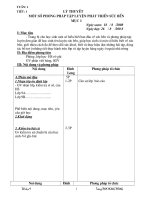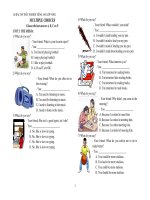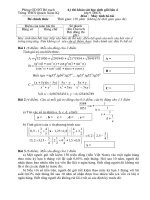9 to 5 - Do You Know if Your Boss Knows Where You Are pot
Bạn đang xem bản rút gọn của tài liệu. Xem và tải ngay bản đầy đủ của tài liệu tại đây (252.9 KB, 38 trang )
I N F RA S TR U CTUR E, SAF ETY,
A N D EN V IR ONMENT
CHILD POLICY
CIVIL JUSTICE
This PDF document was made available from www.rand.org as a public
service of the RAND Corporation.
EDUCATION
ENERGY AND ENVIRONMENT
HEALTH AND HEALTH CARE
Jump down to document6
INTERNATIONAL AFFAIRS
NATIONAL SECURITY
POPULATION AND AGING
PUBLIC SAFETY
SCIENCE AND TECHNOLOGY
SUBSTANCE ABUSE
TERRORISM AND
HOMELAND SECURITY
TRANSPORTATION AND
INFRASTRUCTURE
The RAND Corporation is a nonprofit research
organization providing objective analysis and effective
solutions that address the challenges facing the public
and private sectors around the world.
Support RAND
Purchase this document
Browse Books & Publications
Make a charitable contribution
For More Information
Visit RAND at www.rand.org
Explore RAND Infrastructure, Safety, and Environment
View document details
Limited Electronic Distribution Rights
This document and trademark(s) contained herein are protected by law as indicated in a notice
appearing later in this work. This electronic representation of RAND intellectual property is provided
for non-commercial use only. Permission is required from RAND to reproduce, or reuse in another
form, any of our research documents for commercial use.
This product is part of the RAND Corporation technical report series. Reports may
include research findings on a specific topic that is limited in scope; present discussions of the methodology employed in research; provide literature reviews, survey
instruments, modeling exercises, guidelines for practitioners and research professionals, and supporting documentation; or deliver preliminary findings. All RAND
reports undergo rigorous peer review to ensure that they meet high standards for research quality and objectivity.
9 to 5: Do You Know If
Your Boss Knows Where
You Are?
Case Studies of Radio
Frequency Identification Usage
in the Workplace
Edward Balkovich, Tora K. Bikson, Gordon Bitko
Approved for public release; distribution unlimited
The research described in this report results from the RAND Corporation's continuing
program of self-initiated research. Support for such research is provided, in part, by donors
and by the independent research and development provisions of RAND's contracts for the
operation of its U.S. Department of Defense federally funded research and development
centers.
Library of Congress Cataloging-in-Publication Data
Balkovich, Edward.
9 to 5 : do you know if your boss knows where you are? : case studies of radio frequency indentification usage in
the workplace / Edward Balkovich, Tora K. Bikson, Gordon Bitko.
p. cm.
“TR-197.”
Includes bibliographical references.
ISBN 0-8330-3719-6 (pbk. : alk. paper)
1. Electronic monitoring in the workplace—United States. 2. Radio frequency—identification. 3. Radio
frequency identification systems—United States. 4. Employee rights—United States. 5. Privacy, Right of—United
States. I. Title: Nine to five. II. Title: Radio frequency identification usage in the workplace. III. Bikson, Tora K.,
1940– IV. Bitko, Gordon. V. Title.
HF5549.5.E37B35 2004
331.25'98—dc22
2004027392
The RAND Corporation is a nonprofit research organization providing objective analysis
and effective solutions that address the challenges facing the public and private sectors
around the world. RAND’s publications do not necessarily reflect the opinions of its research
clients and sponsors.
Rđ is a registered trademark.
â Copyright 2005 RAND Corporation
All rights reserved. No part of this book may be reproduced in any form by any electronic or
mechanical means (including photocopying, recording, or information storage and retrieval)
without permission in writing from RAND.
Published 2005 by the RAND Corporation
1776 Main Street, P.O. Box 2138, Santa Monica, CA 90407-2138
1200 South Hayes Street, Arlington, VA 22202-5050
201 North Craig Street, Suite 202, Pittsburgh, PA 15213-1516
RAND URL: />To order RAND documents or to obtain additional information, contact
Distribution Services: Telephone: (310) 451-7002;
Fax: (310) 451-6915; Email:
Preface
Radio Frequency Identification (RFID) tags are finding their way into a broad range of new
applications that have raised concerns about privacy. There is little to inform the calls for a
national debate and the legislative proposals that have resulted. The concerns expressed
demonstrate how emerging information technologies can upset the balance of privacy,
personal benefits, and public safety and security. Although proposed retail uses are new,
RFID tags have been used to control access in the workplace for over a decade. We became
interested in how existing workplace policies might serve to inform a larger debate about
how to weigh competing needs when new technologies or new uses disturb existing balances.
We undertook a replicated case study of six enterprises to understand their policies for
collecting, retaining, and using records obtained by sensing RFID-based access cards. We
found that the workplace policies we surfaced share a number of common features (data are
used for more than access control, access control system records are linked with other
enterprise databases, and security and employment practices trump privacy concerns) and
that these policies are not communicated to employees.
This report results from the RAND Corporation’s continuing program of selfinitiated research. Support for such research is provided, in part, by donors and by the
independent research and development provisions of RAND’s contracts for the operation of
its U.S. Department of Defense federally funded research and development centers.
iii
Contents
Preface................................................................................................................................... iii
Figure and Tables .................................................................................................................. vii
CHAPTER ONE
Introduction...........................................................................................................................1
CHAPTER TWO
Privacy in the Workplace.........................................................................................................5
CHAPTER THREE
Methods.................................................................................................................................7
CHAPTER FOUR
What We Found .....................................................................................................................9
Architecture of the RFID Systems Studied..................................................................................9
Responses to Interview Questions............................................................................................ 10
CHAPTER FIVE
Results ................................................................................................................................. 15
CHAPTER SIX
Discussion............................................................................................................................ 17
Recommendations ................................................................................................................. 17
Reality Versus Recommendations ............................................................................................ 19
Conclusions .......................................................................................................................... 20
Appendix: Interview Questions ............................................................................................... 23
References............................................................................................................................. 27
v
Figure and Tables
Figure
1. Elements of a Typical RFID Access Control System ...................................................... 10
Tables
1. RFID Access Control System Characteristics ................................................................ 11
2. Users and Uses of the RFID Access Control System Data............................................... 12
3. Policies Related to RFID Access Control System Data ................................................... 13
vii
CHAPTER ONE
Introduction
New information technologies have created unprecedented opportunities to collect, store,
and transfer information. Technology can be applied to make our lives both easier and safer,
but it can also diminish our privacy and civil liberties. Effective decisionmaking about relationships among personal convenience, public safety, security, and privacy requires many
kinds of knowledge. Together with Carnegie Mellon University, we outlined an empirical
approach to generating such knowledge (Balkovich et al., 2004).
As a starting point, RAND examined a commonly used information technology—Radio Frequency Identification (RFID) tags in access cards. Access cards are often used
in the workplace to control entry to facilities. Data describing a card’s use by an individual
employee can be collected by an access control system and analyzed. This common deployment of RFID technology should require policies to balance the concerns of personal convenience, security, and privacy when access cards are used. This report examines such contemporary workplace policies.
RFID technology is on a path that promises to make it a pervasive technology
(Covert, 2004). There are high-profile private- and public-sector commitments to its use in
tagging and tracking objects (Feder, 2003; Henry, 2003). These commitments are based on
the perceived benefits of the technology. Those benefits include improvements in logistics,
supply chain management, and retail sales (RFID Journal, 2002a, 2002b; “About EPCGlobal
Inc.,” 2003). They also include security applications such as that of the Mexican federal judiciary (Weissert, 2004) and proposed improvements to patient management in hospitals
(Schwartz, 2004).
These perceived benefits must be balanced against concerns about privacy. Proposed
retail uses of RFID tags have generated some of the greatest concerns (see, e.g., Albrecht,
2002, 2003). Such concerns about potential abuses of the technology have, in turn, spurred
legislative proposals to limit its use in California, Missouri, Utah, Massachusetts, Maryland,
and Virginia1 as well as calls for a national policy discussion (Leahy, 2004). This privacy debate is primarily about a use of RFID technology—retail sales—that is yet to be deployed, let
alone understood.
Although RFID technology is far from being as pervasive as retail sales might eventually make it, it is already in widespread use in workplace access cards. We hope to inform the
debate about future uses by studying the policies and behaviors in existing uses. In this re____________
1A
summary of proposed state legislation can be found in “2004 RFID Legislation,” 2004.
1
2
9 to 5: Do You Know If Your Boss Knows Where You Are?
port, we examine these policies from the perspective of organizations using RFID-based systems to control access to their facilities.
To be sure, differences exist between RFID in tags for objects and RFID in access
cards. The use of RFID in access cards, credit cards (e.g., Exxon Mobil Oil Corporation,
2003), and toll tags (e.g., New Jersey Department of Transportation, 2004) are all “cooperative” uses of RFID technology. That is, individuals agree to enroll in programs that offer the
personal convenience of using RFID and presumably choose when to do so. Similarly, access
cards are often a condition of employment as well as an individual convenience, and employees typically know when they are using them. In contrast, objects with RFID tags that come
into the possession of retail customers expose those individuals to “uncooperative” reading of
the tag, i.e., the tag carried by an individual may be read without that individual knowingly
participating in the exchange. (Of course, such uncooperative reading of RFID tags is also
possible with access cards, credit card proxies, or toll tags.)
Despite these significant differences, what might be learned from studying access
cards? As with other uses of RFID, access cards offer clear benefits to persons and institutions. An access card is arguably more convenient to use than a key and, from an organizational perspective, offers a more cost-effective way to implement physical security. However,
these benefits come with a price: Using the device changes an individual’s degree of privacy.
In our results we discuss how policy is formulated and explore how sensor data about
access card use, linked to individuals, are handled. Explicit or de facto data-handling policies
will need to be formulated for all applications that can link sensor data to individuals. Experience with access cards can inform how such policies should be created because access card
systems have already grappled with procedures that govern the retention and use of personally identifiable data.
We conducted case studies of six private-sector organizations and their policies for
the collection and use of personally identifiable information obtained from access cards.
These access cards rely on RFID technology to make them simple and easy to use. RFID tags
are usually embedded in small plastic objects that can be attached to key rings, or in a card
similar to a credit card. In the latter case, photographs or text can be printed on the card to
provide visible information about its bearer. An access card is typically issued to and used by
a single individual—like a key—to gain entry to physical facilities (such as a building or a
room within a building).
Cards with embedded RFID tags are a simple, easily understood illustration of competing concerns and how such concerns are balanced:
• The access card provides personal convenience. It is easier and simpler to carry and use
than a physical key—it must merely be waved near a reader.
• The access card provides security. Typically, a door lock is controlled by the system
reading the access card. The card authorizes access to a controlled location for its
bearer, allowing finer-resolution entry controls and making it difficult for those without authorization to enter.
• The access card reveals otherwise private information about an individual. It enables the
collection of data about each use of the card that can be assembled into a picture of
its user’s behavior. Unlike a physical key, the access card has a unique identifier that
is typically associated with only one person and provides a way for the access control
system to observe the behavior of individuals as the cards are used.
Introduction
3
Since RFID-based access card technology has been in workplace environments for
some time, it provides an opportunity to study policies governing the retention and use of
the personally identifiable information it generates. Our approach is a replicated case study
to address the following broad questions:
1. Are there common principles underlying private sector privacy policies for data generated
by RFID-based access control systems?
2. Are these policies communicated to the employees who use access cards?
We begin our discussion with an overview of privacy in the workplace. We follow
that with an explanation of the methodology used. We then present a summary of answers to
the research questions provided by our respondents. We close with an analysis and discussion
of our findings.
CHAPTER TWO
Privacy In the Workplace
Privacy in the U.S. workplace has few protections. The Electronic Communications Privacy
Act of 1986 (ECPA, 86) is a U.S. federal statute that establishes the privacy of employee
communications in the workplace. It generally prohibits the interception of electronic communications but specifically allows employers to monitor their networks for business purposes and in particular to monitor communication networks with employee consent—actual
or implicit.
These broad exceptions enable employers to monitor all forms of electronic communications in the workplace (e.g., e-mail, instant messaging, voice calls, voice mail), so long as
the results of such monitoring are not used to punish labor-organizing activities. This constraint arises from the National Labor Relations Act (NRLA, 1935). Much of the advice
available to employees and employers about workplace privacy (e.g., EPIC, 2004; and PR,
2004) concludes that there is very little workplace privacy in the United States.
A review of federal and state privacy statutes (Smith, 2002; Smith, 2004) in the
United States does not reveal any legislation specifically dealing with employee monitoring
through tracking their use of access cards. However, as noted in PR, 2004, permissible monitoring of the use of employer-supplied computers does enable an employer to keep track of
when an employee is at or away from a computer—a rudimentary form of employee tracking.
Although the U.S. legal formulations of privacy allow employers to create employee
agreements that effectively eliminate any expectation of privacy, other frameworks exist or
have been proposed. European employers are bound by data protection acts that limit the
purposes and scope of data collection about employees and limit data retention. A 1996 International Labor Organization code of practice (ILO, 1996) argues that collection and use
of data about employees should be consistent with fair information practices (U.S.
Department of Health, Education and Welfare, 1973). This includes ensuring that employees are notified about data collection and that the data are used only for the purposes for
which they were originally collected. Against this background, we thought it worthwhile to
examine emerging U.S. workplace procedures and practices for handling RFID-generated
data. The six private-sector enterprises we studied have implemented very similar (explicit or
de facto) policies for the retention and use of access control system records. All but one use
the personally identifiable data collected by the system to do more than open doors. None of
them informs employees about these policies. Hence, our choice of title for this report—9 to
5: Do You Know If Your Boss Knows Where You Are?
5
CHAPTER THREE
Methods
Our approach involves a replicated case study of six organizations. The organizations we
chose all have 1,500 or more employees. All are in the private sector. Two are nonprofits,
two are high-tech manufacturers, and two are media services firms (content producers).
For each organization, we identified role incumbents responsible in some capacity for
the operation of the access control system (e.g., a director of security) and asked them questions about their organization’s use of RFID. Our questions covered the following topics:
• Architecture of the RFID-based access control system
• Integration of access control with other systems
• Data collected by the access control system and the linkage of its records to other databases
• Uses of access control system records
• Policies governing the retention and use of access control system records
• Existence of written policy descriptions and their availability to employees
• Role of the access control system policymakers in the organization.
Participating organizations were asked to identify role incumbents with knowledge in
these areas to be interviewed. Interviewees were provided with a list of questions in advance
(see the appendix). Interviews were conducted either face-to-face or by phone. The interviews were structured by our list of questions and focused on clarifying the interviewees’ answers. In some cases, phone or e-mail follow-up discussions were used to amplify initial responses.
We interviewed representatives of the U.S.-based operations of these six organizations. Their responses refer to their U.S.-based workplaces, even though many of these organizations have an international presence. Our interview questions did not explore differences
in approach that might characterize an office located outside of the United States. Given that
there are significant differences among national protections for workplace privacy, such an
exploration would be a valuable extension of our work.
To verify the accuracy of our findings, participants were asked to review a written
summary of their interview. Participants were assured confidentiality and were offered draft
copies of reports and presentations describing the results of our study to confirm their unidentifiability.
7
CHAPTER FOUR
What We Found
We begin with a brief discussion of the architecture of the access control systems included in
the study. Architecturally, these systems are very similar, although they differ in some technical details. We have abstracted the responses into a single description with only enough detail
to understand the answers to our interview questions. We then present in more detail the
answers to the remaining study questions provided by the six participating organizations.
Architecture of the RFID Systems Studied
The conceptual elements of the access control systems used by all the organizations in our
case studies are illustrated in Figure 1. Each system comprises a number of antennas used to
interrogate RFID tags embedded in access cards, electronics for data acquisition and control,
the lock or some other physical security feature under the control of the system, network integration of the distributed electronics, and a centralized database that records the details of
the use of access cards. After scanning an access card, the system determines whether the card
(and corresponding individual) is authorized entry (or exit) and unlocks the barrier (if
authorized to do so). A record of that transaction is (optionally) captured in a database. A
high-level explanation of the technologies used to implement RFID tags can be found in
Want (2004).
Records stored in the database typically include the unique identifier of an access
card, the location of the antenna and lock where it was read, and the time and date it was
read. By using a concordance that maps unique identifiers of access cards to the names of the
individuals who were issued the cards, this data collection can provide a history of an individual’s card use. Given a name or person number, transaction records can also be linked to
other records about the individual.
The typical access card system provides an interface (not shown in Figure 1) that allows the system operator to activate and deactivate access control cards and to query the
database. Generally, the implicit network connecting RFID readers to the database system is
logically or physically separated from other workplace networks. The ability to make database queries and perform data extracts is restricted to a small number of authorized individuals by limiting the terminals that can be used to query the database, controlling physical
access to those terminals, and authenticating access control system database users. Tamperresistant auditing of queries and extracts made by user accounts typically provides an additional way to ensure that the records of an access control system are used appropriately.
9
10
9 to 5: Do You Know If Your Boss Knows Where You Are?
Figure 1
Elements of a Typical RFID Access Control System
Embedded RFID Tag
Access Card
Air Interface
Database of
Transactions
Data Acquisition
and Control
Antenna
Lock
RAND TR197-1
Responses to Interview Questions
System Characteristics
Table 1 summarizes the individual characteristics of the access control systems of the organizations we interviewed. The rows of the table represent the six organizations studied (A
through F). The columns characterize their responses to our questions about the scope of the
access control system and its relationship to other security systems.
The RFID-based access controls used by the participants in our study are not new
systems. They have been in use a minimum of four years (C) and as long as a decade or more
(e.g., B). Every system has the capability of recording the unique identity of a card and the
time, date, and location of the card’s use.
The scope of an access control system can be the entire enterprise (company-wide) or
a subset of its facilities. The RFID-based system may be the only way access is controlled (exclusive use), or it may be combined with other access controls, e.g., guarded lobbies that do
not require an access card to be scanned by an RFID reader (nonexclusive use). For example,
during primary business hours a guard might control employee access to the main entrance
of a facility by examining employee credentials (often printed on the access card),
What We Found
11
Table 1
RFID Access Control System Characteristics
Case
Category
Years
Used
Data Collected
System Scope
Integration with Other
Sensors
A
Nonprofit
7
User, time, location
Company-wide, exclusive,
external and internal
PIN #; manually with video
B
Nonprofit
15
User, time, location
Company-wide, non-exclusive,
external and internal
PIN #, CCTV, alarm systems
C
High-tech
manufacturing
4
User, time, location
Company-wide, nonexclusive,
external and internal
PIN #, CCTV
D
High-tech
manufacturing
7
User, time, location
Company-wide, nonexclusive,
external and internal
PIN #, photo ID, CCTV
E
Media services
10
User, time, location
Company-wide, nonexclusive,
external and internal
None
F
Media services
8
User, time, location
Company-wide, nonexclusive,
external and internal
PIN #, photo ID, CCTV,
alarm system
whereas the access control system might be the only access method used during off hours or
at other entrances of the same facility. Access cards can be used to control the periphery of an
institution’s facilities (external control) and/or to limit access to designated areas within a
facility (internal control).
All the enterprises we studied use RFID-based access controls throughout the organization both to control peripheral access to facilities and to limit access to designated areas
within a facility. Most uses of RFID access cards are nonexclusive—both automated access
controls and guards are used to control access in multiple facilities of the organization. Only
one organization (A) makes exclusive use of access cards.
Access control systems can be integrated with other systems. For example, doorways
and their associated RFID readers are often under the surveillance of a closed-circuit TV
(CCTV) camera or video recording system. Typically, data from different systems can be
viewed using the same terminal. In some (manual) cases, card transaction data and other
data, e.g., a video stream, may need to be viewed at separate terminals.
Access control points may require the bearer of a card additionally to provide a personal identification number (PIN #) for the card to be recognized. This provides verification
that the card is in the possession of the person to whom it was issued. PIN numbers are often
used to control access to limited areas within an organization (internal access controls), such
as a room with sensitive or otherwise highly valuable content.
Access controls can also be integrated with a photo ID system to assist in verification.
In this case, the scanning of an access card causes a photo (obtained from an enrollment database indexed by the unique identifier of the access card) to be displayed to a guard who can
use it to verify the identity of the bearer of the card.
Finally, access control systems may be integrated with alarm systems so that alarms
can be automatically raised via the access control system when unauthorized entry is attempted.
All but one of the participating organizations (E) integrate their access control system
with some other system. Manual and automated video systems are common (A, B, C, D, and
12
9 to 5: Do You Know If Your Boss Knows Where You Are?
F), as are PIN numbers for card verification (A, B, C, D and F). Less common are alarm systems (C and F) and photo ID systems (D and F).
Users and Uses of Data
Data collected by RFID access control systems can be used by multiple parts of an enterprise.
An enterprise’s security function is the obvious user, but other typical users include line
managers and the human resources (HR) and legal departments. Records can be used in ways
that personally identify individuals or in aggregate forms that limit the ability to identify individuals. In the latter case, records about multiple individuals are extracted from the database of the access control system, and personally identifying information is removed prior to
analysis. In the former case, a typical use might be investigation of asset theft or of compliance with company timekeeping policies. In the case of one respondent (F), record usage also
included the investigation of an e-mail threat from an employee’s allegedly compromised
workstation.
Table 2 shows who uses the data collected by RFID access control systems and in
what ways. Security is the primary user. However, the majority of organizations studied also
have other users of RFID access control data. These are typically the HR department (A, C,
and D), the legal department (C and D), or line management (A, C, and D). Beyond security functions, additional uses rely on both personally identifiable forms of the data and aggregate forms of the data.
Personally identifiable data are typically used to investigate an incident, e.g., theft, or
to prove or disprove allegations of employee misconduct (A, B, C, D, and F). Some participants reported that personally identifiable data are also used for public safety, e.g., to account
for employees after events that have the potential to harm them or to plan emergency procedures (A and F). In contrast to monitoring individual employee behavior, in one instance (C)
personally identifiable data were used to monitor and ensure group compliance with established corporate work rules (e.g., attendance hours) after the acquisition of another company
(work culture monitoring). Only one organization (E) limits the use of its RFID access control system to simply controlling access.
Table 2
Users and Uses of the RFID Access Control System Data
Case
Category
Individually Identified
Data Uses
Data Users
Aggregate Data Uses
A
Nonprofit
Security, HR, line
managers
Individual investigations, public
safety
Access logistics
B
Nonprofit
Security
Individual investigations
Logistics; cost analysis
C
High-tech
manufacturing
Security, HR, line
managers, legal
Individual investigations; work culture
monitoring
Government-required logistics
D
High-tech
manufacturing
Security, HR, line
managers, legal
Individual investigations, location
access checks
None
E
Media services
Security
None
None
F
Media services
Security
Individual/threat investigations,
personal safety
Security logistics
What We Found
13
Aggregate data are used by a majority of the respondents for logistics (A, B, C, and
F). Uses ranged from studying arrival and departure patterns (A, B, and F), e.g., to ensure
that heavily used entrances had adequate staff or RFID readers to avoid backups at peak
hours, to providing government-required information (C)—in this case, to an Air Quality
Management District.
Policy and Policymaking
We asked respondents to comment on the following facets of policy related to RFID access
control system data: retention of data, auditing practices, publication of policies, policymakers, and allowed linkage to other personally identifiable data. Their responses are summarized
in Table 3.
Policies should be developed to govern the use of records collected by access control
systems. There are several important policy dimensions. The most obvious is the enforcement of policies governing access to and analysis of the captured records. Policy also requires
specification of a data retention interval. Such rules typically require audits to ensure compliance by the organizational units charged with collecting and protecting data assembled by
access control systems. These policy choices may or may not be explicitly communicated to
the employees who use RFID-based access control systems.
No participating organization has a limited data retention policy. All retain all access
control system data indefinitely.
Most of the organizations we studied audit the use of their system records (B, C, D,
and F), generally by means of a self-audit. Self-audits are conducted by the organizational
unit responsible for operating the access control system. 1 Two organizations do not conduct
audits at all (A and E). Only one employs an external auditor (C). The external auditor is not
part of the enterprise.
Table 3
Policies Related to RFID Access Control System Data
Case
Category
Data Control
Explicit Policies
Policymaker
Other Database
Links
A
Nonprofit
Stored indefinitely,
no audits
No
Corporate security
Manually to HR
B
Nonprofit
Stored indefinitely,
self-audit
No
Corporate security
Manually to HR
C
High-tech
manufacturing
Stored indefinitely,
external audit
No
Corporate facilities/
security
HR
D
High-tech
manufacturing
Stored indefinitely,
self-audit
Yes. Held within
security
Corporate security
Manually to HR
E
Media services
Stored indefinitely,
no audits
No
Corporate security
Manually to HR
F
Media services
Stored indefinitely,
self-audit
No. Operational
Facility operations
procedures in security
Medical records/
HR
____________
1 This
is in contrast to an internal audit, in which a separate unit of the organization, e.g., Finance, conducts the audit.
14
9 to 5: Do You Know If Your Boss Knows Where You Are?
Most organizations do not have explicit (written) policies governing the use of RFID
access control system records (A, B, C, E, and F). By this, we mean they have no enterprisewide policy statement explaining the retention, uses, or authorized users of the records collected by the access control system. One company (D) has an explicit policy, but it is not
provided to all employees—only to those in the security function of the organization. Another (F) maintains a written set of procedures for operating the access control system. These
rules were not described as enterprise-wide policy. Thus, the organizations we studied have
no permanent enterprise statement of the rules nor a guarantee that an enterprise-wide process will be used to maintain or change the rules. In our view, therefore, they have no written
enterprise-wide policy. Responsibility for creating the policies governing issues such as retention and use of access control system records can reside with the organizational unit operating the system (typically a security function) or can be viewed as an institutional obligation
of an officer of the enterprise. In every case we studied, the policymaker is either the security
or facilities department. These departments are also responsible for operating the access control system. None of the organizations we studied regarded the policy for access control system data retention and use to be an enterprise-wide policy that should be managed and overseen by an officer of the enterprise (e.g., a vice president).
Last, every organization indicated that the records collected by the access control system were linked (via an employee’s name or similar identifier) to other enterprise databases.
These linkages always included personnel records (HR) and in one case (F), included medical
records. In that instance, the linkage to medical records was used to allow first responders to
a medical emergency to scan an employee’s badge to call up relevant medical records (e.g.,
known allergies). The linkage to personnel records is inevitable because individual employees
are generally assigned uniquely identified cards, and this concordance needs to be maintained
for administrative purposes (e.g., revocation of a lost card). In two cases (C and F), the linkage of access control system records to other records is fully automated.
CHAPTER FIVE
Results
It is quite clear from our six cases that the enterprises studied have many things in common
about the way they use access control systems and the data they generate. Several principles
stand out:
Linkage of access control system records with other personally identifiable data is
commonplace. Access control systems are typically integrated with other forms of surveillance, such as video cameras, and the two sources of surveillance data are routinely linked.
Linkage with personnel records is also commonplace. Most surprising was the linkage (albeit
in only one case) with medical records.
Linkage with video cameras serves a security need. It is typically used either to verify
the identity of the user of an access card (e.g., by displaying an enrollment photo that a
monitor can compare to the video image from a remote location) or for forensic purposes
(e.g., after a theft of assets).
The linkage of access control system and personnel records is also not surprising because a routine use of RFID access control system records appears to be investigations of
misconduct. These are routine in the sense that they are planned although not necessarily
frequent. Other routine uses of aggregate data include planning and monitoring, both internal (e.g., flow of employees through an entrance) and external to the enterprise (e.g., reporting attendance information to a regional government for air quality management purposes).
There is a clear public safety motivation for the linkage to medical records and, in
this case (F), there is a written policy (developed by the security department) for the use of
the access control system data. Nevertheless, linkage with medical records raises additional
privacy and operational considerations.
Arguably, these are all legitimate uses of access control system records. In at least two
cases (D and F), the rules for use are explicitly defined. Although access control systems provide features that support audits of their use, the majority of audits of compliance with policy are internal ones overseen by the same organizational unit that operates the access control
system.
The final principle emerging from our case study sites is that access control system
records are retained indefinitely. Our interviews did not explore why there is an apparent
reluctance to destroy records after some length of time. Since the data can be used as evidence in criminal investigations and to justify employee sanctions, it may be that enterprises
feel compelled to retain them in the event that actions based on the data are appealed.
Although the policies of the cases studied have common features, the employees of
the participating enterprises are not likely to know what those policies are. Knowledge of the
policies is typically limited to the people and organizational units concerned with security
15









